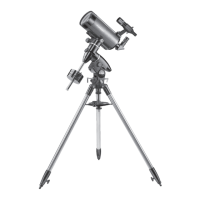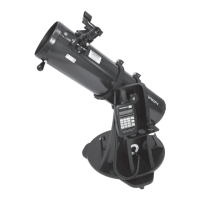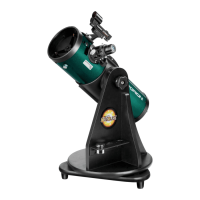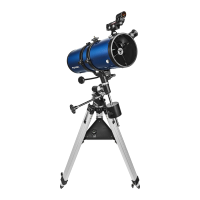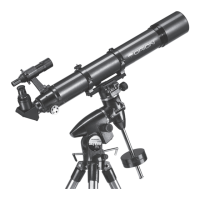13
B.The Sun
You can change your nighttime telescope into a daytime Sun
viewer by installing an optional full-aperture solar filter over
the front opening of the StarMax 127mm EQ. The primary
attraction is sunspots, which change shape, appearance, and
location daily. Sunspots are directly related to magnetic activ-
ity in the Sun. Many observers like to make drawings of
sunspots to monitor how the Sun is changing from day to day.
Important Note: Do not look at the Sun with any
optical instrument without a professionally made
solar filter, or permanent eye damage could result.
C.The Planets
The planets don’t stay put like the stars, so to find them you
should refer to Sky Calendar at our website (telescope.com),
or to charts published monthly in Astronomy, Sky &
Telescope, or other astronomy magazines. Venus, Mars,
Jupiter, and Saturn are the brightest objects in the sky after
the Sun and the Moon.Your StarMax 127mm EQ is capable
of showing you these planets in some detail. Other planets
may be visible but will likely appear star-like. Because planets
are quite small in apparent size, optional higher-power eye-
pieces are recommended and often needed for detailed
observations. Not all the planets are generally visible at any
one time.
JUPITER The largest planet, Jupiter, is a great subject for
observation. You can see the disk of the giant planet and
watch the ever-changing positions of its four largest moons -
Io, Callisto, Europa, and Ganymede. Higher-power eyepieces
should bring out the cloud bands on the planet’s disk.
SATURN The ringed planet is a breathtaking sight when it is
well positioned.The tilt angle of the rings varies over a period
of many years; sometimes they are seen edge-on, while at
other times they are broadside and look like giant “ears” on
each side of Saturn’s disk. A steady atmosphere (good see-
ing) is necessary for a good view. You will probably see a
bright “star” close by, which is Saturn’s brightest moon, Titan.
VENUS At its brightest, Venus is the most luminous object in
the sky, excluding the Sun and the Moon. It is so bright that
sometimes it is visible to the naked eye during full daylight!
Ironically, Venus appears as a thin crescent, not a full disk,
when at its peak brightness. Because it is so close to the Sun,
it never wanders too far from the morning or evening horizon.
No surface markings can be seen on Venus, which is always
shrouded in dense clouds.
MARS The Red Planet makes its closest approach to Earth
every two years. During close approaches you’ll see a red
disk, and may be able to see the polar ice cap.To see surface
detail on Mars, you will need a high-power eyepiece and very
steady air!
D.The Stars
Stars will appear like twinkling points of light. Even powerful
telescopes cannot magnify stars to appear as more than a
point of light.You can, however, enjoy the different colors of the
stars and locate many pretty double and multiple stars. The
famous “Double-Double” in the constellation Lyra and the gor-
geous two-color double star Albireo in Cygnus are favorites.
Defocusing a star slightly can help bring out its color.
E. Deep-Sky Objects
Under dark skies, you can observe a wealth of fascinating
deep-sky objects, including gaseous nebulas, open and glob-
ular star clusters, and a variety of different types of galaxies.
Most deep-sky objects are very faint, so it is important that
you find an observing site well away from light pollution. Take
plenty of time to let your eyes adjust to the darkness. Do not
expect these subjects to appear like the photographs you see
in books and magazines; most will look like dim gray
smudges. Our eyes are not sensitive enough to see color in
deep-sky objects except in a few of the brightest ones. But as
you become more experienced and your observing skills get
sharper, you will be able to ferret out more and more subtle
details and structure.
How to Find Deep-Sky Objects: Star Hopping
Star hopping, as it is called by astronomers, is perhaps the
simplest way to hunt down deep-sky objects to view in the
night sky. It entails first pointing the telescope at a bright star
close to the object you wish to observe, and then progressing
to other stars closer and closer to the object until it is in the
field of view of the eyepiece.It is a very intuitive technique that
has been employed for hundreds of years by professional and
amateur astronomers alike. Keep in mind, as with any new
task, that star hopping may seem challenging at first, but will
become easier over time and with practice.
Figure 10. Star hopping is a good way to locate
hard-to-find objects. Refer to a star chart to map
a route to the object that uses bright stars as
guideposts. Center the first star you’ve chosen
in the finder scope and telescope eyepiece (1).
Now move the scope carefully in the direction of
the next bright star (2), until it is centered.
Repeat (3 and 4). The last hop (5) should place
the desired object in the eyepiece.

